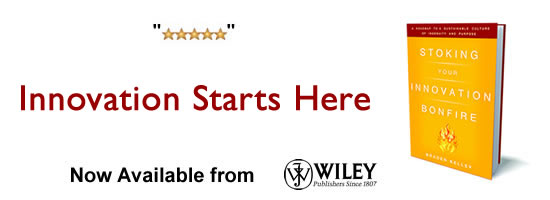Four Simple Layers to Frame Government Innovation for the Next Presidential Administration and Beyond
Editor’s note:  Co-authored with Troy Barker
 Today, the concept of government innovation has rapidly moved to the top of the public policy dialogue with the increasing recognition that, like private industry, government should push itself to innovate and transform how it delivers services to its citizens. Over the past 20 years there has been growing interest in government innovation and the notion of optimizing the government’s ability to innovate and reinvigorate public policies and services. Everybody loves to talk about innovation, particularly in the context of what government or the public sector can achieve. The concept of innovation creates excitement with the promise of introducing transformational improvements to society. However, as soon as we move beyond the high level concept of innovation in the public sector to the brass tacks of how it actually gets done in a sustainable way, the conversation bogs down very quickly. Stakeholders diverge in their views of the proper role of public sector in catalyzing innovation and lack a framework for discussing the essential components, we recommend organizing the discussion around a simple four-layer model.
Today, the concept of government innovation has rapidly moved to the top of the public policy dialogue with the increasing recognition that, like private industry, government should push itself to innovate and transform how it delivers services to its citizens. Over the past 20 years there has been growing interest in government innovation and the notion of optimizing the government’s ability to innovate and reinvigorate public policies and services. Everybody loves to talk about innovation, particularly in the context of what government or the public sector can achieve. The concept of innovation creates excitement with the promise of introducing transformational improvements to society. However, as soon as we move beyond the high level concept of innovation in the public sector to the brass tacks of how it actually gets done in a sustainable way, the conversation bogs down very quickly. Stakeholders diverge in their views of the proper role of public sector in catalyzing innovation and lack a framework for discussing the essential components, we recommend organizing the discussion around a simple four-layer model.
The four layers of innovation ecosystem, innovation policy and structure, innovation leadership, and innovation management comprise a simple organizing framework to advance government innovation for the next presidential administration and beyond.
To begin, let’s define the four layers that comprise the organizing framework.

1)    Innovation Ecosystem: Similar to a biological ecosystem that includes all living organisms as well as the physical environments in which they live, the innovation ecosystem is comprised of all of the major actors that are engaged in driving advancements in economic, technological, and overall societal outcomes through innovation. When asked to identify the key actors in innovation, many people will point to private sector technology leaders, Silicon Valley startups, and renowned research universities. However, actors can be viewed more broadly to include material resources such as funds, equipment, and facilities, human resources such as public and private sector employees and students, and institutions and associations including non-profits and government agencies in the United States and around the world. Government has historically been seen as a lever to spur and encourage innovation in the private sector for the purpose of stimulating the economy. In this role, government focused on developing programs, grants, and other funding streams designed for private sector organizations to consume. When it came to innovation, government was simply seen as only an enabler of innovation. The actual innovation itself would come from some other place in the private sector, academia, or the non-profit sector. The shift in thinking over the last decade is that government should and is participating in conceiving, promoting, and implementing innovation as opposed to standing on the sidelines watching while other parts of the ecosystem do the innovating. Critical to the conversation specifically related to government innovation is how to continue positioning government as an effective and active participant in this complex and rapidly evolving ecosystem. How can the government continue to both add value and contribute to the larger ecosystem while also pulling from it as well?
2)    Innovation Policy and Structure: Similar to corporate strategies in private sector organizations, public policies are critically important in government because they essentially capture, document, and communicate government’s intentions. They serve as guidance and a rallying cry to federal workers about where government intends to go.   A powerful way for government to engage in and influence the innovation ecosystem is through the creation and dissemination of innovation policy. Innovation policy guides not only the actions of government employees but also sends a powerful signal to the market as to the priorities of the government participating in the innovation ecosystem as a participant, consumer, and enabler. The 2015 White House Strategy for American Innovation is one example of government policy that sends a strong signal to both public sector employees and the broader innovation ecosystem regarding the go forward investment and purchasing priorities to achieve desired societal outcomes. Additionally over the past several years, the Office Science and Technology Policy (OSTP) residing in the Executive Office of the President has led the way in accelerating innovation at the Federal level combined with many federal agencies launching innovation centers of excellence or innovation labs. With all of this said, in order to effectively craft and implement innovation policy, the government needs to thoroughly analyze how to better organize or structure itself in a way to improve on the progress made around innovation. How can all of government work together in a coordinated way to drive innovation forward? How should each federal agency rally around innovation so that the innovation labs within each agency are not the only part of the organization where innovation is happening? How should the federal, state, and local levels of government work together to share best practices and innovations that improve the lives of citizens? And finally, what can the US federal government learn from other governments around the world? Maturing innovation policy and organizing government to promote and sustain government innovation is really in its infancy with a myriad of opportunities and challenges within it.
3)    Innovation Leadership: Innovation leadership refers to the practice of government senior executives creating cultures that encourage and reward innovation throughout the organization. Innovation leadership requires more than high level directives and vision statements to be effective. It requires building innovation leadership in depth to cascade the directives, encouragement, and rewards to the critical middle level of the organization that often drives the way projects are procured and executed. Building innovation leadership in depth also buffers the organization against a loss of momentum for innovation that can come with changes in political appointees or the rotation to the private sector of key innovation leaders. As innovation policy and structure cascade down, innovation leadership is needed to promote and reinforce policy while at the same time structuring the organization of government in a way that promotes innovation. Yet how does a government executive go about leading? In James Q. Wilson’s landmark book Bureaucracy: Why Government Organizations Do What They Do, Wilson discusses the motivators and de-motivators that confront all federal employees around risk aversion and how difficult it is to get anything done due to the morass of government red-tape. With this said – what is the leadership posture within a government agency to let the rank and file know that their new ideas want to be heard? It’s not that federal workers don’t have innovative ideas, it’s that, in many cases, they may have been conditioned to suppress and not bring those ideas forward because those ideas would “buck the system.â€Â Working to develop a culture of innovation where all within an organization apply innovative thinking to solving the policy issues of the day is the type of innovation leadership needed within all organizations including the US federal government.
4)    Innovation Management: While innovation leadership can set the course for the organization in prioritizing innovation and ensuring that it does not deviate in times of change, innovation management is required to effectively achieve the desired advancements in societal outcomes from specific project investments. A robust innovation management approach ensures that effective methodologies, frameworks, and processes are in place to guide an organization through the full innovation lifecycle from upfront ideation through to back-end evaluation. Innovation management is necessary for a government agency to move beyond aspirational goals to be more innovative to the brass tacks of achieving the advancements in societal outcomes that justify program dollars invested. In building out an effective innovation management system, a multi-disciplinary approach can and should be deployed. Drawing from such disciplines as strategic planning, program management, quality and risk management, monitoring and evaluation systems, process improvement, and organizational design, effective innovation management systems can be developed to help organizations go from an idea to something tangible that adds value to the organization and ultimately citizens.
Four-Layer Model to Frame Government Innovation
Each of the four layers are critically linked to the others. It is important for the government to stay plugged in to the larger innovation ecosystem to not only be a consumer but also a contributor to innovation in all fields or sectors. Continuing to work with the private sector, non-profits, and academia to drive innovation forward is critical for the progress and advancement of new ideas, processes, and technologies that can help the government deliver better policy outcomes and citizen service. Efforts to build out innovation policy and structure in government are in the early stages but gaining momentum. While some work has been done in this area, there is a long way to go. Policy guidance is necessary to “set the stage†while work around how to best structure government organizationally is really just beginning. Innovation leadership creates and sustains the organizational environment required to implement and prioritize innovation management. One the key issues with innovation leadership is the notion of how to make it sustainable as political appointees and other government leaders come in and out of their leadership roles or transition to new roles. How can innovation leadership be institutionalized so that it is not dependent on just the personalities of the current set of leaders? And lastly, designing and deploying sound innovation management processes within government organizations helps bring ideas to life to create improved public value.
In upcoming posts, we will further explore the intricacies within each of the four layers, the issues that reside within them, and the most critical linkages between them that help to promote the government’s role as an active and effective participant in the innovation ecosystem.
Wait! Before you go…
Choose how you want the latest innovation content delivered to you:
- Daily — RSS Feed — Email — Twitter — Facebook — Linkedin Today
- Weekly — Email Newsletter — Free Magazine — Linkedin Group
 Dr. Michael “Whit†Whitaker is Vice President of Emerging Solutions for ICF International. He is responsible for fostering a culture of innovation where creative thinking, experimentation, prototyping, rapid iteration, and deep understanding of markets, clients, and end-user needs are used to develop new solutions that drive growth and customer satisfaction in rapidly emerging markets. Follow Whit on Twitter or connect on LinkedIn
Dr. Michael “Whit†Whitaker is Vice President of Emerging Solutions for ICF International. He is responsible for fostering a culture of innovation where creative thinking, experimentation, prototyping, rapid iteration, and deep understanding of markets, clients, and end-user needs are used to develop new solutions that drive growth and customer satisfaction in rapidly emerging markets. Follow Whit on Twitter or connect on LinkedIn
 As a Senior Vice President of the Information Planning and Management line of business at ICF, Troy Barker leads a consulting practice focused on bringing a myriad of technology and management solutions to government clients.  Mr. Barker holds a Master of Policy Management from Georgetown University and a BA in Social Sciences from St. Ambrose University. He is also a member of the ACT-IAC Institute for Innovation. You can read more thought leadership from ACT-IAC Institute for Innovation members here.
As a Senior Vice President of the Information Planning and Management line of business at ICF, Troy Barker leads a consulting practice focused on bringing a myriad of technology and management solutions to government clients.  Mr. Barker holds a Master of Policy Management from Georgetown University and a BA in Social Sciences from St. Ambrose University. He is also a member of the ACT-IAC Institute for Innovation. You can read more thought leadership from ACT-IAC Institute for Innovation members here.
NEVER MISS ANOTHER NEWSLETTER!
LATEST BLOGS
Three things you didn’t know about credit cards
Photo by Ales Nesetril on Unsplash Many of us use credit cards regularly. From using them for everyday purchases to…
Read MoreFive CV skills of a business-minded individual
Photo by Scott Graham on Unsplash The skills listed on a CV help employers quickly understand your suitability for a…
Read More


